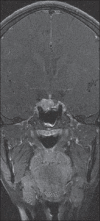Resistant prolactinoma: Is it monoclonal or polyclonal?
- PMID: 24251135
- PMCID: PMC3830281
- DOI: 10.4103/2230-8210.119534
Resistant prolactinoma: Is it monoclonal or polyclonal?
Abstract
Prolactinomas are solitary benign neoplasms and resistance to dopamine agonists occur in a small percentage of prolactinomas. Multiple pituitary adenomas are reported in less than 1% of pituitary adenomas and rarely result in resistant prolactinoma. We recently encountered an interesting patient of hyperprolactinemia with multiple pituitary microadenomas. Dopamine agonist use resulted in prolactin normalization and subsequent pregnancy resulted in drug withdrawal. Repeat evaluation after delivery showed a macroprolactinoma and dopamine agonist therapy resulted in biochemical cure without reduction in tumor size. We report the case for its presentation with multiple microadenomas progressing to macroprolactinoma suggesting polyclonal in origin.
Keywords: Multiple pituitary adenoma; polyclonal; resistant prolactinoma.
Conflict of interest statement
Figures
Similar articles
-
Hyperprolactinemia and prolactinoma.Handb Clin Neurol. 2014;124:185-95. doi: 10.1016/B978-0-444-59602-4.00013-7. Handb Clin Neurol. 2014. PMID: 25248588 Review.
-
Hyperprolactinemia: pathophysiology and management.Treat Endocrinol. 2003;2(1):23-32. doi: 10.2165/00024677-200302010-00003. Treat Endocrinol. 2003. PMID: 15871552 Review.
-
Hyperprolactinemia/Prolactinomas in the Postmenopausal Period: Challenges in Diagnosis and Management.Neuroendocrinology. 2019;109(1):28-33. doi: 10.1159/000494725. Epub 2018 Oct 22. Neuroendocrinology. 2019. PMID: 30347396 Review.
-
Surgical outcomes in hyporesponsive prolactinomas: analysis of patients with resistance or intolerance to dopamine agonists.Pituitary. 2005;8(1):53-60. doi: 10.1007/s11102-005-5086-1. Pituitary. 2005. PMID: 16411069
-
Prolactinomas and menopause: any changes in management?Pituitary. 2020 Feb;23(1):58-64. doi: 10.1007/s11102-019-00998-0. Pituitary. 2020. PMID: 31686376 Review.
Cited by
-
Lower PRDM2 expression is associated with dopamine-agonist resistance and tumor recurrence in prolactinomas.BMC Cancer. 2015 Apr 12;15:272. doi: 10.1186/s12885-015-1267-0. BMC Cancer. 2015. PMID: 25884948 Free PMC article.
-
Double pituitary adenomas are most commonly associated with GH- and ACTH-secreting tumors: systematic review of the literature.Pituitary. 2017 Dec;20(6):702-708. doi: 10.1007/s11102-017-0826-6. Pituitary. 2017. PMID: 28766078
-
Isolated double adrenocorticotropic hormone-secreting pituitary adenomas: A case report and review of the literature.Oncol Lett. 2016 Jul;12(1):585-590. doi: 10.3892/ol.2016.4673. Epub 2016 Jun 1. Oncol Lett. 2016. PMID: 27347184 Free PMC article.
References
-
- Molitch ME. Dopamine resistance of prolactinomas. Pituitary. 2003;6:19–27. - PubMed
-
- Jastania RA, Alsaad KO, Al-Shraim M, Kovacs K, Asa SL. Double adenomas of the pituitary: Transcription factors Pit-1, Tpit, and SF-1 identify cytogenesis and differentiation. Endocr Pathol. 2005;16:187–94. - PubMed
-
- Asa SL, Ezzat S. Molecular basis of pituitary development and cytogenesis. In: Kontogeorgos G, Kovacs K, editors. Molecular pathology of the pituitary. Vol. 32. Basel: Karger; 2004. pp. 1–19. - PubMed
-
- Gillam MP, Molitch ME, Lombardi G, Colao A. Advances in the treatment of prolactinomas. Endocr Rev. 2006;27:485–534. - PubMed
-
- Herman V, Drazin NZ, Gonsky R, Melmed S. Molecular screening of pituitary adenomas for gene mutations and rearrangements. J Clin Endocrinol Metab. 1993;77:50–5. - PubMed
Publication types
LinkOut - more resources
Full Text Sources
Other Literature Sources



